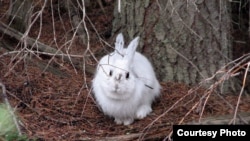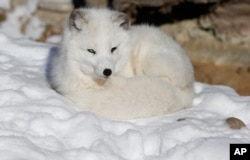One of the worst consequences of wearing the wrong color for the season: an embarrassing fashion faux pas. But the stakes are much higher in the animal world, a new scientific study shows.
Professor L. Scott Mills compares snowshoe hares to the "ice cream cone of the forest."
"My carnivorous graduate student likes to call them the cheeseburgers of the forest, meaning that they're eaten by pretty much every predator out there," Mills said.
The hares' most important survival tool is camouflage, he said. The typical wild hare sheds its brown coat and changes to white in winter to blend in with the snow.
But these bunnies stand out like light bulbs if they grow their winter coats before the onset of the snowy season, and again in spring if the snow melts away before the change back to brown fur.
Mills and his team from the University of Montana and North Carolina State University wondered about the survival rates of snowshoe hares running around in white against brown backdrops. They posit this could occur more often in future winters due to global warming.
High cost of color
The research team tracked nearly 200 snowshoe hares in Montana with radio collars over three years.
"We find that the cost of being mismatched is substantial,” said Mills, who co-authored the work published earlier this month in the peer-reviewed journal Ecology Letters. “Every week that a hare is mismatched, it has a 7 percent lower chance of surviving than a hare that is not mismatched."
If there's any hopeful news here, he said, it's that hares display wide variation in the timing of their coat color molt.
So the next question is whether, through natural selection and evolution, the animals can adjust to "decreasing winter."
Case in point: Hares along the Pacific Northwest coast and Olympic Peninsula have evolved to stay brown all winter.
University of Alberta professor Stan Boutin has studied red squirrels in the Canadian Yukon for more than two decades. He says they have demonstrated the capacity to keep pace with environmental change.
"One of the key take-homes is that in a small mammal like a squirrel — or even the snowshoe hares — the ability to evolve as the ecological conditions change is definitely there,” he said. “They can do so quite rapidly."
Two helpful factors, according to Boutin, are a short time between generations of a species and high levels of inherent variation.
Beyond bunnies
The bunny-tracking team led by Mills is expanding its field work globally to other species that change coat colors seasonally.
"We're starting to study Arctic foxes in Sweden,” Mills said. “We're starting to study mountain hares in Scotland and Ireland. I should mention that in Scotland, they turn from brown to white; and in Ireland the same species stays brown, kind of like the Olympic hares do here."
The team is also interested in weasels such as ermine. White-tailed jackrabbits also hold interest.
Within the last year, the Mills lab gained the ability to do controlled experiments with captive hares in an indoor habitat. Mills oversaw the construction of several chambers where daylight duration and temperature can be adjusted independently to test which factors affect the molt.
Captive bunnies also make it easier to investigate genetic influences, as well as to conduct behavioral studies.
"We can put animals on white backgrounds and brown backgrounds and see whether they choose to be on white when they are white and brown when they're brown,” Mills said. “Do they choose to reduce mismatch with behaviors?"
Until now, field observations have suggested the hares don't modify their behavior much to reduce their vulnerability when their natural fur camouflage misaligns with the snow duration.
















